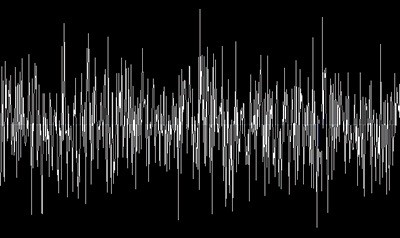
Introduction: Tuning Noise
With the inauguration of the 45th President of the United States, Donald J. Trump, an infusion of visual, aural, and public activism has arisen in America. Protest, public outcry, and political speak seem to be weekly responses to the Republican deconstruction of the Obama legacy, including the demise of democratic policies, and a reversal of progressive policies that shored up healthcare for all and LGBTQ+ rights. Trump’s policies are an undoing of all of this and more, an undoing of our potential as humans—backing out of climate control agreements, deregulation of Wall Street, renewed militarization of police—all the progress that the United States has made in the past decade, undone in less than a year. Amidst all this undoing, the backward stepping, the regression, it seems the protests and public outcry, while massive in their responses, have little effect. Like social media itself, these protests have trended and faded as quickly as tweets, newsfeeds, and Instagram posts—these political outcries are amplified by media coverage only to be tuned out with the latest outrageous statement issued by the White House or tweeted by the current President luminescing across electronic screens. All of the “noise” created by an outraged public is masked by the latest murmurs undulating from Mar-a-Lago. In this essay, I argue that in order to disrupt a dominant narrative, using sound (noise) as a method of solidarity and empowerment, the frequency of the disruption needs to cut through the narrative and not just mask the underlying noise. The process of masking noise creates a cancellation of both the original message and the disrupting noise, which efficaciously silences the original sound (or originating voice). While this is an effective method of controlling what is heard, seen, and interpreted, it doesn’t do enough to change the politic or power dynamics. I will trace a short history of how the noise of motorcycles has been used to disrupt and change power structures within the LGBTQ+ political consciousness and I will examine how motorcycle noise has masked conservative, radical, and hate-filled speech, masked progressive anti-death penalty vigils, all while deafening protest and failing to necessarily force policy changes. And finally, in an effort to look and listen at how protest masks populist formations of noise, I argue that specific disruption can offer structural changes to political power at all levels of government when the noise created isn’t tuned out.
The Visual and the Aural (I see what you say)
We live in an ocular-dominant time. W. J. T. Mitchell writes, “[i]t is a commonplace of modern cultural criticism that images have a power in our world undreamt of by the ancient idolaters.”1 Visual memes are more powerful than the printed word, and while some may argue that between Twitter, Facebook, blog-culture, self-publishing, and other forms of social media, text-based communication dominates the airwaves, our visual sensorial experiences drive market forces via brand recognition, televisionistic priorities, and Instagram fame. Auditory and aural sensations seem to fall behind our visual-based experiences. You have to see it to believe it. But, visual iconography can be easily misread, appropriated, skewed and eventually so-exhausted in the public eye that the image no longer signifies its original referent, or as Frederic Jameson reminds us, we live in a postmodern world where signifiers are no longer attached to meaning but are free-form referents available for reattachment, reappropriation, and culturally in flux.2 In this essay, I am not concerned with the visual signifier of the motorcycle, or the image of the motorcycle, instead I will look at the phenomenological, political, and cultural meanings of the sound of the motorcycle, the noise of pipes, rumblings of engines, and the political performance of noise as motorcycles disrupt meaning and power. As scholar Lilian Radovac argues “only by situating technologies in a larger field of power relations, social structures and capital forms does it become possible to see how power enables certain practices while disabling others, thereby shaping what technologies are and how they are used at different conjunctures.”3 The motorcycle, thus, is more than the technology of engine, chassis, exhaust system. It is a signifying system, and is used to disrupt, empower, and radically reshape social relationships as well as political positions.
Like visual culture scholars’ attention to both the visual and discourses around the visual, sound studies addresses both the “sound or aural subject” and the “object of discourses of aurality.”4 As Nicole Fleetwood theorizes that “visibility implies the state of being able to be seen, while visualization refers to the mediation of the field of vision and the production of visual objects/beings,” so, too does audibility imply a state of being able to be heard, and auralization (or audition) as the mediation of the field of aurality and the production of aural objects/beings.5 Noted sound studies scholar Jonathan Sterne reminds us that aurality and audibility (or audition) have key differences as both a sensorial experience and in terms of constructing meaning, producing the political, and referencing positionality). Key concepts differentiating aurality from visuality are offered up in Sterne’s “audiovisual litany.” Sterne writes, “hearing is spherical, vision is directional; hearing immerses its subject, vision offers a perspective; hearing is concerned with interiors, vision is concerned with surfaces; hearing is a primarily temporal sense, vision is a primarily spatial sense; hearing brings us unto a living world, sight moves us toward atrophy and death.”6 I do not necessarily agree with all of Sterne’s litany, as each of his pairings could be deconstructed and argued against when thinking about light/sight as a time based medium—however, it is worth considering how and why Sterne differentiates hearing vs. seeing, in a culture that tends to construct a motorcycle studies that privileges the seeing of the motorcycle over the hearing of the motorcycle.
The hearing of motorcycles seems to take precedence over the seeing of them in both the legislative and social realms, specifically considering the noise of motorcycles. The bumper sticker slogan “loud pipes saves lives” is an attempt by motorcyclists (riders) to justify an overly disruptive sound of motorcycle exhaust systems, namely the tailpipes (pipes). As a result of government legislating acceptable noise levels (in the US), riders have campaigned to shift public opinion by appealing to a sense of safety (saving lives). Distinguishing what constitutes “loud” or considering the decibels of acceptable motorcycling isn’t just a legal code. What constitutes noise is both a literal and conceptual construction. Sitting at the center of this investigation of noise as protest, noise as political disruption, is the question of how the “noise” of the motorcycle performs. In audio production, noise refers to any “unwanted” sound. It can refer to sound that is generated by fluorescent lights, ambient exterior sound of traffic, construction, wind, and other weather or manmade sounds that creep into our field of listening. Determining what is unwanted is both subjective and has positionality as well as a phenomenological orientation. That is, when determining what is noise, I must consider what is my position to this sound; is the noise masking another more desired (or desirable) sound—who determines what is desired—what is the level of interruption? Acousticians have developed Noise Criteria or NC (a rating system) that identifies how “soundproof” from noise various rooms like recording studios, concert halls, theatres (stage and film), and even stadiums are. All of these types of spaces can be configured, controlled, and designed to reduce the impact of noise. Theorist Jacques Attali notes in his seminal essay on Noise that in “noise can be read the codes of life, the relations among men . . . when it is fashioned by man with specific tools, when it invades man’s time, when it becomes sound, noise is the source of purpose and power, of the dream.”7 Drawing from Attali’s theories of noise, Jonathan Sterne points out, “[Noise] is a simulacrum of violence.”8 And it is precisely the noise of motorcycles that can provoke anxiety and provoke solidarity, political action for both the right and left factions of political groups in the United States.
Motorcycles and Noise
Controlling the unbridled sounds of motorcycles has long been a part of the public consciousness, especially since the 1960s and 1970s, when, as racer, engineer and motorcycle restorer John Glimmerveen notes, “digital electronic decibel sound meters became universally available adding a scientific approach to quantifying exhaust noise.”9 In the UK, The Noise Abatement Society was established in 1959. In 1972, the US Environmental Protection Agency offered the Noise Control Act of 1972 in which standards of noise control for various products manufactured and sold in the US would be established. Thus, the federal government (in the US) sets and enforces uniform noise control standards for motorcycles along with aircraft, workplace conditions, railroads, and medium- and heavy-duty trucks. Other noise-generating products are regulated by state and local governments. As determined by the EPA, “[t]he standards for motorcycles only apply to those manufactured after 1982 and range from 80 to 86 dbA depending on the model year and whether the motorcycle is designed for street or off-road use.”10 For California, the standard limit is 90 decibels. So, the regulation of individual motorcycles is set by public policy and enforced by local law enforcement. Triple AAA (the American Automobile Association) a major “non-profit organization of motor clubs serving the US and Canada” lists each state and province’s legal noise level threshold for motorcycles as measured in decibels. For California, recent legislation requires that “[m]otorcycles registered in the state that are manufactured on or after 2013 or have an aftermarket exhaust system manufactured on or after 2013 must have the federal EPA noise emission label affixed to it in order to be operated, used, or parked in the state.”11 Even parking (sitting at rest, sitting with the potential of movement) is subject to noise control in the Golden State.
A Short History of Dykes on Bikes® (1970s) Getting Loud
The 1970s in the US was a time when EPA standards were being established, as well as the beginning of an organized environmental movement, the second wave of feminism (Women’s Rights or ERA), and an “out” LGBTQ+ movement. These various political action groups demanded to be heard in public—sounding forces through marches, parades, and other public performative actions.12 In 1970, Christopher Street Liberation Day was established in Greenwich Village, New York. Christopher Street West (Los Angeles) also took place in 1970, as a parade/march in solidarity with what happened at the Stonewall Riots in 1969 and in support of Christopher Street Liberation Day. In addition to Los Angeles’s Christopher Street West, in 1970, Gay Freedom Day was celebrated in San Francisco.13 And for the following three years LGBTQ+ folk marched through the streets of the Castro, demanding to be heard. In 1973, a group of rebellious dykes on bikes—the original (according to San Francisco’s chapter Dykes on Bikes®), unorganized, loosely configured—inserted themselves into the marching protest known as the Gay Freedom Day March in San Francisco. 14 Demanding to be heard, sonically and politically, these women interrupted and created noise via their motorcycles, sounding off unwanted murmurs of lesbian sisterhood, and lesbian politics, as a way to change the parade from featuring men or the struggle of “gay men” to the exclusion of women (the visual dominance of male contingents)—to include their sisters. It’s not that women weren’t present at the Gay Freedom Day. Women were tired of marching in the shadows of men, under the name of “gay,” which locates queer sexuality in the realm of “men”—marginalizing women, bisexuals, transgender, and later queer and questioning identifications. Women on motorcycles created noise in order to change their position in the discourse of gay rights. Dykes on Bikes® revved their engines, and inserted unwanted noise into the pedestrian polemics of gay men in San Francisco. From 1973 onward (1976 marks the official establishment of San Francisco’s Dykes on Bikes® as a motorcycle contingent), women gathered in numbers reconstructing the configuration and the meaning of Pride parades. In the 1970s, only a handful of dykes rode in the parade. By the 1980s, Dykes on Bikes® (in San Francisco) had established a business license, organized as an official Parade contingent—calling themselves the Women’s Motorcycle Contingent—and had been unofficially named “Dykes on Bikes” by the media (see fig. 2 & 3). Several hundred bikes would line up to start the parade. By the early 2000s, a record 450 bikes orchestrated a sonic cacophony of political power. Obviously, the advances in gay rights, LGBTQ+ visibility, and changes in public opinion on gay marriage and other LGBTQ+ legal statuses have advanced from decades of organization, political pressures, iconic allies like Mayor Gavin Newsom, and purposefully disruptive protests of groups like Queer Nation, ACT UP, and HRC’s campaigns to eradicate devastating pandemics that affect us all worldwide like AIDS. But in their own way, Dykes on Bikes® has rallied queer motorcyclists all over the world in the effort to make noise and bring equal rights and equity into LGBTQ+ and straight ridership consciousness. What began as disruptive, unpredictable, and spontaneous has become regular, expected noise that saturates LGBTQ+ Prides worldwide.
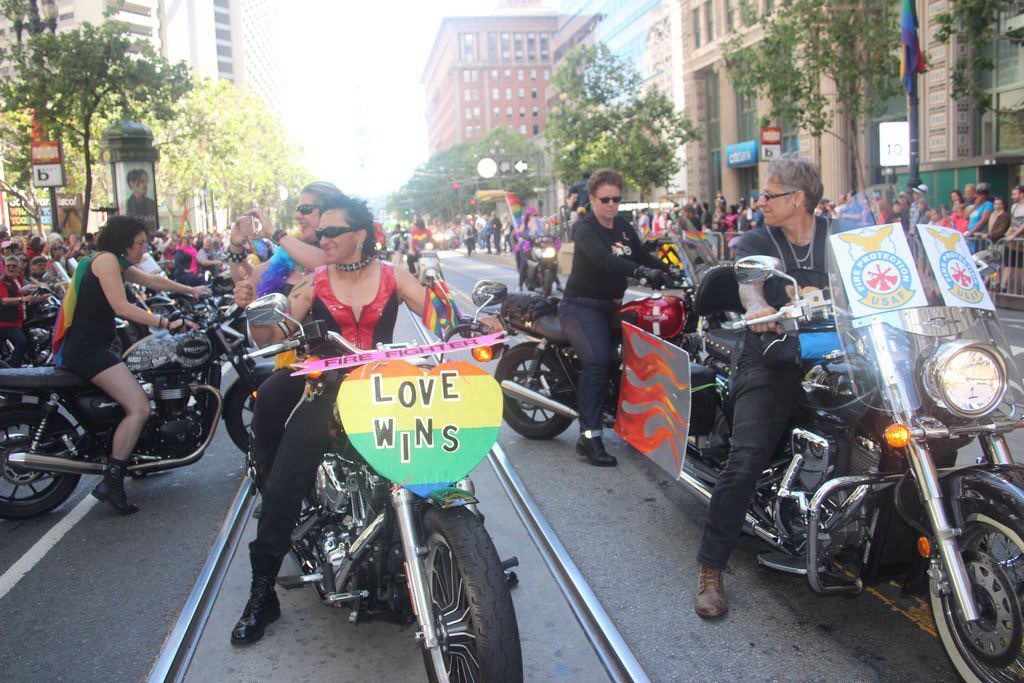
Through the process of trademarking their name, San Francisco Dykes on Bikes® represents the mother chapter in an institutionalized system of chapters—Australia, UK, Iceland, Portugal, Spain, Canada, and multiple states in the US (e.g. see fig. 4). Is it still disruptive? Perhaps not, however, the noise that Dykes on Bikes® makes each year does produce an aurality, and a visuality, both of which signify resistant politics through the performance of riding at the front of the parade, and through sheer numbers, loudness, decibels. These decibels challenge the very ordinances of legal noise.
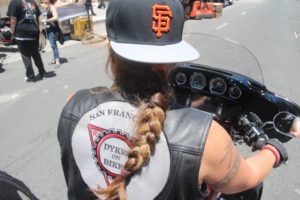
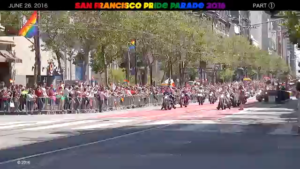
source: Party Of The Third Part. SF Pride Parade 2016, Part 1: Dykes on Bikes, Motorcyclists, Bicyclists, and a Truck. N.p. Film.
https://www.youtube.com/watch?v=2Uid4_jy6zo
In the case of Dykes on Bikes®, noise creates a disruption to the normative, to the grand narrative of heterosexuality, of male-dominated structures of power—whether it be the motorcycling industry, LGBTQ+ organizations, or even lesbian and feminist groups that critique masculinity, butchness, and the term dyke. And even the legal battles surrounding the trademarking of their name reveals how Dykes on Bikes disassembles what is normative and challenges legal precedents.15 In contrast, the group known as the Thin Blue Line Motorcycle Law Enforcement Motorcycle Club (the Thin Blue Line MC) masks disruptive noise. Masking in sound is the “phenomenon where one sound obscures another, usually one weaker and higher in frequency.”16
Masking Protest
For the Thin Blue Line MC, the common denominator is supporting fellow officers, officers’ families, military troops, and military families. The political position becomes irrelevant with the performance of masking. Masking opposition, free speech, and alternative perspectives in the name of institutional power, police solidarity, and military sacrifices is what counts. The state power is supported and substantiated by the presence of the Thin Blue Line MC. What resonates is the harmonics of Harleys, the throttling of exhaust, and the vibration of forces that drown out the undesirable. They drown out the condemned. This video excerpt is from a recent “performance/protest” where the Thin Blue Line MC gathered at a Texas State execution where anti-death penalty organizers also assembled in an effort to protest the state sanctioned execution of Daniel Lopez, a prisoner found guilty of killing a police officer in 2009 (e.g. see fig. 5).

source: “Fire Them up! – YouTube.” https://www.youtube.com/watch?v=YxyLFMw7Fx8
The Thin Blue Line Law Enforcement Motorcycle Club defies critiques that through their presence and performance at executions that they are supporting the execution. According to a statement made on their official Facebook page they write, “We are not there to cheer the execution of a murderer. We are there for the family. To let them know that they will never be alone. The last thing that the murderer will hear as he enters the gates of hell, is the roar of our pipes! Semper Cop!”17 The sound becomes a deafening articulation of the solidarity of state enacted violence, an effect that burns the ears of protestors, sound that affects listeners in what sound scholar David Suisman calls a “social and political act and as a physiological, emotional experience.” 18 Unlike Dykes on Bikes® the Thin Blue Line MC holds power through exclusionary practice/performance; it shuts down the possibility of other expressions. The sonic force of Harleys or other bikes fitted with customized pipes literally moves the air to envelop and distort the human voice. The group gathers in numbers in order to cover the voices of protesters. Like the Thin Blue Line MC, The organization known as the Patriot Guard Riders coalesces as a unit of massive audible machines, masking—hateful speech spewed by The Westboro Baptist Church members who protest the funerals of US American Soldiers who have died in Iraq and Afghanistan (see fig. 6).
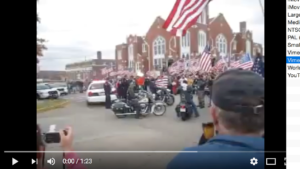
The Patriot Guard Riders group covers the sounds of amplified, sensational rhetoric, spewing from bullhorns. According to the Patriot Guard Riders’ official website, “The Patriot Guard Riders is a diverse amalgamation of riders from across the nation. [They] have one thing in common besides motorcycles. [They] have an unwavering respect for those who risk their very lives for America’s freedom and security including Fallen Military Heroes, First Responders and honorably discharged Veterans.” 19 Their purpose according to their mission is to “shield the mourning family and their friends from interruptions created by any protester or group of protesters.” They clearly view their position within the law and in terms of non-violence: “We accomplish the latter through strictly legal and non-violent means.” The Patriot Guard Riders, like the Thin Blue Line MC, mask the bullhorns of protestors like the Westboro Baptist Church. The Westboro Baptist Church is a religious right-wing-fundamental extremist organization. Even amplified, the Westboro clamorings become inaudible as distinct words recede to a level reserved for low-hum buzzing, or static white noise, relegated to meaningless sonic waves. The masking of the Westboro Baptist Church’s sounds aligns the Patriot Guard Riders with left-wing groups who support LGBTQ+ rights through a common goal of “silencing” or neutralizing “hate speech” —hate speech that is broadcast by members of the Westboro Baptist Church. The neutralizing and obscuring of the voices of anti-death penalty protestors aligns the Thin Blue Line MC with right wing political causes that support the death penalty as a legitimate, just, and usable punishment in the United States. These two examples, in a US context are potentially representative of political extremes, and yet ideologically the Thin Blue Line Law Enforcement MC and the Patriot Guard Riders are both organizations that support the power and presence of the nation-state, the government, police action, and military forces.
Conclusion—Make Noise
The noise of bikes, the rumble of pipes, the thunder of machines, the howling of hogs, the low frequency of combustion, and the vibration of air arrest the ears of listeners—listeners at protests, at parades, at processions. Where you hear the sonic explosion perhaps dictates how you hear the intention of the rider, the message of the motorcyclist, the mission of the organization, the call of the collective—through the firing of pistons, the unifying of running motors. Political positions, political messages, and even policies are turned over through the tuning of air/exhaust systems. Dykes on Bikes®, the Thin Blue Line MC, and the Patriot Guard Riders might find that through the masking of dominant, deviant, and alternative messages, feedback from the very system of power producing resistance creates deafening silences. Asking the listener to listen more deeply, to consider the frequencies that might be inaudible and to consider the possibility that masking doesn’t always drown out the other side, but sometimes distorts and destroys the potential of harmonic possibilities, by sonically surrounding silence.20 Creating noise means we indicate our position, our politics. As we recognize noise as noise, we need to listen, not normalize the sound. We need to make noise, not mask noise. We need to disrupt. Noise creates space; noise reverberates; noise is unexpected; noise interjects; noise makes us feel (something); noise makes us think. Noise can be disruptive, and productive. And if we normalize noise, we run the risk of not being heard.
A recurring mantra of “not normalizing” the behavior of Donald Trump, or not normalizing the policies and statements issued by the current White House and Republican party seems to be a constant craving of the progressive left. By normalizing, we accept the tweets as presidential, we accept name-calling as diplomacy, and we accept celebrity culture as intellectual substance. In the field of sound engineering, the process of normalizing sound depletes the sound wave of its dynamic range, usually fitting the engineered sound into a predetermined range setting the peaks and valleys of volume to fit more neatly into a desired range. Normalizing the current political spectrum in a way negates or masks the massive protests that have occurred in 2017. And certainly, one of the largest protests heard and seen was the Women’s March which took place on January 21st, 2017—resounding around the world, blanketing whole crowds in a sea of pink. The pink “pussy” hat has left a visual impact on the world, but has it actually disrupted the system? Is there too much visual noise? Could a sonic strategy move its progressive platforms forward more quickly? In this age of Trump we need to amplify, project, and disrupt. As Radovac points out, “this combination of volume and happenstance is what makes amplified street speech an interventionist political form, and its location in public space is what gives it its potentially radical inflection. It is also what makes one person’s free speech another person’s noise.”21 We need to make noise in order to be heard. Noise to intervene, noise to participate politically in a world that is already so noisy. And in the wise words of Dr. Seuss,
They blew on bazookas and blasted great toots on clarinets, oom- pahs and boom-pahs and flutes! Great gusts of loud racket rang high through the air. They rattled and shook the whole sky! And the mayor called up through the howling mad hullabaloo: “Hey, Horton! How’s this? Is our sound coming through?22
Notes
- W. J. T. Mitchell, Iconology: Image, Text, Ideology (Chicago, IL: University of Chicago Press, 1986), 8. ↩
- Frederic Jameson, Postmodernism, Or, The Cultural Logic of Late Capitalism (Durham, NC: Duke University Press, 1991), 8-9 ↩
- Lilian Radovac, “Muting Dissent: New York City’s Sound Device Ordinance and the Liberalization of the Public Sphere,” Radical History Review 121 (January 2015): 33, https://doi.org/10.1215/01636545-2799899. ↩
- Nicole R. Fleetwood, “Introduction,” in Troubling Vision: Performance, Visuality, and Blackness (Chicago; London: The University of Chicago Press, 2011), 15. ↩
- Fleetwood, “Introduction,” 16. ↩
- Jonathan Sterne, ed., The Sound Studies Reader (Routledge, 2012), 9. ↩
- Jacques Attali, Noise: The Political Economy of Music (Manchester, UK: Manchester University Press, 1985), 6. ↩
- Jonathan Sterne, “Quebec’s #casseroles: On Participation, Percussion and Protest,” Sounding Out! (blog), June 4, 2012, https://soundstudiesblog.com/2012/06/04/casseroles/. ↩
- John Glimmerveen, “Motorcycle Exhausts—2-Stroke Expansion Chambers,” ThoughtCo, accessed January 11, 2018, https://www.thoughtco.com/motorcycle-exhausts-2-stroke-expansion-chambers-743311. ↩
- OA US EPA, “Summary of the Noise Control Act,” Overviews and Factsheets, US EPA, February 22, 2013, https://www.epa.gov/laws-regulations/summary-noise-control-act. ↩
- “Motorcycle Noise Limits,” AAA Digest of Motor Laws, accessed January 11, 2018, http://drivinglaws.aaa.com/tag/motorcycle-noise-limits/. ↩
- Dan Berger, The Hidden 1970s: Histories of Radicalism (New Brunswick, NJ: Rutgers University Press, 2010), 5). ↩
- “San Francisco Pride: Heritage and Photos,” accessed September 1, 2017, http://www.sfpride.org/heritage-and-photos/. ↩
- “Dykes on Bikes| HISTORY,” accessed January 11, 2018, https://www.dykesonbikes.org/history. ↩
- “Dykes on Bikes | HISTORY,” accessed January 11, 2018, https://www.dykesonbikes.org/history. ↩
- Udo Zölzer, DAFX: Digital Audio Effects (Hoboken, NJ: John Wiley & Sons, 2011), 519. ↩
- “Thin Blue Line Law Enforcement Motorcycle Club,” accessed July 11, 2016, https://www.facebook.com/Thin-Blue-Line-Law-Enforcement-Motorcycle-Club-166793430070050/. ↩
- David Suisman, “The Oklahoma City Sonic Boom Experiment and the Politics of Supersonic Aviation,” Radical History Review 2015, no. 121 (January 1, 2015): 169–95, https://doi.org/10.1215/01636545-2800022. ↩
- “Patriot Guard Riders—Welcome to the PGR,” accessed July 11, 2016, https://www.patriotguard.org/content.php?s=56bd1b14593973a1164c91140171bee6. ↩
- Pauline Oliveros, Deep Listening: A Composer’s Sound Practice (New York, NY: iUniverse, Inc., 2005), 15. ↩
- Lilian Radovac, “The Muted City: New York, Noise Control, and the Reconfiguration of Urban Space” (McGill University, 2014), 93, http://digitool.library.mcgill.ca/webclient/StreamGate?folder_id=0&dvs=1516338931393~650 ↩
- Dr. Seuss, Horton Hears a Who!, Reissue edition (New York: Random House Books for Young Readers, 1954), 49-50. ↩